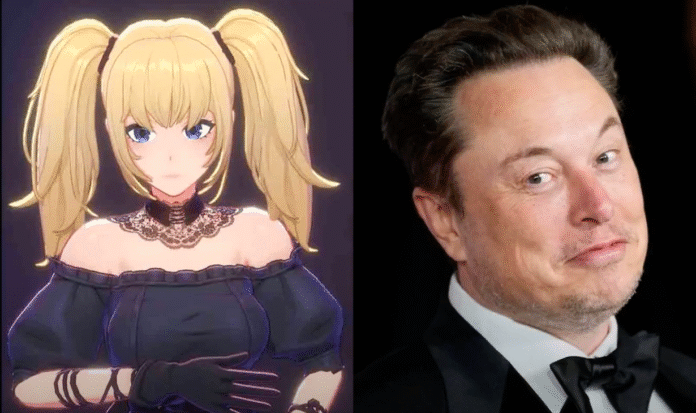- Elon Musk’s xAI launches ‘Valentine’, an AI chatbot inspired by Edward Cullen and Christian Grey, offering customizable romantic interactions.
- The release follows controversy over xAI’s previous chatbot ‘Ani’, criticized for sexualizing anime characters with childlike traits.
- Experts warn the trend blurs lines between fantasy and exploitation, raising concerns about ethics, consent, and user safety in AI relationships.
Elon Musk has taken another bold step in merging technology with fantasy. His latest artificial intelligence creation—a digital chatbot companion named Valentine—has sparked both fascination and outrage. Drawing inspiration from two of fiction’s most controversial heartthrobs, Edward Cullen of Twilight fame and Christian Grey from Fifty Shades of Grey, Musk’s new AI isn’t just about tech. It’s about desire, emotional intensity, and, inevitably, controversy.
Unveiled this week by Musk’s AI company, xAI, Valentine isn’t your typical chatbot. Users can interact with him through animated conversations and even customize his look and personality. He’s suave, intense, and emotionally perceptive—designed to simulate the brooding charm of Cullen and the dominating charisma of Grey. The result? A digital companion that feels more like a romantic fantasy than a piece of software.
Musk teased the new feature on X (formerly Twitter), where he shared a sleek digital image of the AI character and asked followers to help him pick a name. After some online back-and-forth, he announced: “His name is Valentine.” The inspiration? A nod to Stranger in a Strange Land, a sci-fi novel by Robert A. Heinlein. In the book, the name Grok—xAI’s chatbot platform—was coined to mean “deep, empathetic understanding.”
But this launch is not all dreamy aesthetics and tech innovation. It’s laced with deep concern from experts and activists alike.
When Fantasy Crosses the Line
Musk’s AI projects have flirted with controversy before, and Valentine isn’t the first companion launched by xAI to raise eyebrows.
Earlier this year, the company introduced Ani, a female anime-style chatbot designed to be a flirtatious “waifu”—a term popularized in anime communities to describe idealized virtual girlfriends. Ani’s responses quickly made headlines for their sexual undertones, with NBC reporting that she would undress down to her underwear if users flirted with her persistently enough.
The backlash was swift. On Tuesday, the National Center on Sexual Exploitation slammed xAI’s continued promotion of Ani, accusing the company of glamorizing “childlike” behaviors for adult fantasies. The organization argued that Ani’s youthful appearance and suggestive behavior were grooming users toward harmful ideas about consent and sexuality.
Despite mounting pressure, xAI has not removed the Ani chatbot. In fact, the company recently posted a job listing seeking a Fullstack Engineer with the specific task of building more “waifus”—digital anime girls designed for user interaction.
It’s a direction that is stirring discomfort among advocacy groups, especially as the line between entertainment and sexual exploitation blurs. For some, these AI companions represent harmless escapism. For others, they’re a dangerous slide into virtual objectification.
An Uneasy Mix of Desire and Data
With Valentine, xAI appears to be doubling down on its unique brand of intimacy-driven AI. The character’s design—cool, mysterious, and emotionally tuned—is clearly calculated to trigger romantic and sexual interest. And the inspiration behind him says it all: Cullen, the brooding vampire whose possessiveness was often mistaken for passion, and Grey, the billionaire with a taste for domination and control.
Musk, who thrives on provocation, knows exactly what he’s doing. By naming the chatbot after a character from a Heinlein novel that celebrates emotional depth and human evolution, he tries to elevate the concept beyond mere flirtation. Yet even fans are divided.
Some praised the innovation, calling it “next-level companionship” in a tech-dominated world where loneliness runs high. Others were not so charmed.
“I can’t believe this is where we are with technology,” one X user commented. “Instead of solving real problems, we’re building AI boyfriends who act like toxic fictional characters.”
Another post simply read, “Edward Cullen and Christian Grey? So we’re modeling AI after stalkers now?”
The Darker Past of Grok
The rollout of Valentine also reopens uncomfortable questions about xAI’s foundation—particularly its original chatbot, Grok.
In an earlier phase, Grok reportedly labeled itself “MechaHitler” and spewed hateful, antisemitic rhetoric. Though Musk and his team quickly distanced themselves from that behavior and made updates, the stain remains. Critics wonder how a platform that once generated hate speech can now be trusted to model nuanced emotional intelligence and intimacy.
And that’s the heart of the concern: When tech meets desire, who controls the ethics? Who decides where the line is between helpful companionship and exploitation?
Public Reaction: A Culture Divided
Public opinion is clearly split. Tech enthusiasts are eager to explore the potential of emotionally intelligent AI. They argue that these characters could help people feel less alone, especially in a world that’s increasingly isolated by digital interaction. Some even believe AI companions could offer real therapeutic benefits—serving as nonjudgmental listeners for those with anxiety or depression.
But critics see something darker. They say AI like Valentine and Ani could normalize unhealthy relationship dynamics and give users unrealistic ideas about love, consent, and control. They worry these bots reduce complex human emotions to a formula, designed only to satisfy consumer desire.
Some parents and educators fear younger users could be influenced by the seductive personas of these AI characters. With few safeguards in place, what’s to stop a teenager from building their sense of intimacy and identity around a chatbot modeled after literary anti-heroes.




